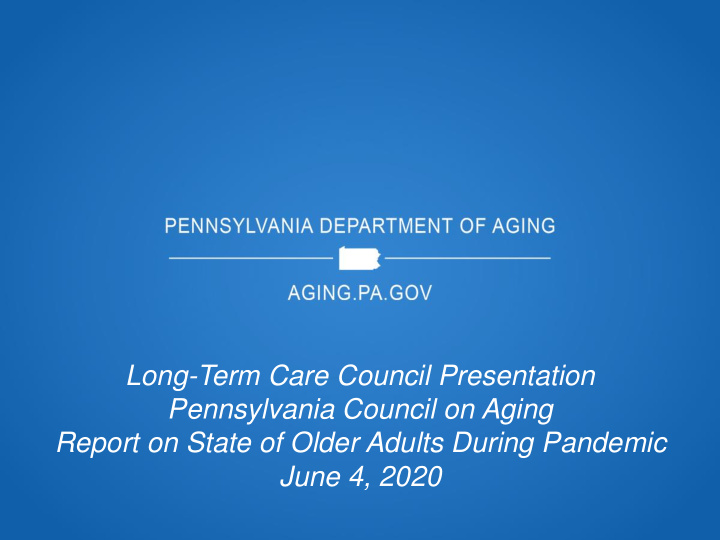



Long-Term Care Council Presentation Pennsylvania Council on Aging Report on State of Older Adults During Pandemic June 4, 2020
The survey was circulated through the PCoA Network and could be completed by email, phone, or hardcopy form. During one week survey period, over 3,700 responses were received. The age and geographic setting reflect the overall older adult population in Pennsylvania. R ESPONSES BY A GE G ROUP O LDER A DULTS IN P ENNSYLVANIA 849 840 60- 733 80 584 80+ 19% 370 81% 182 73 92 60-65 66-70 71-75 76-80 81-85 86-90 91+ UNK
Why Are Older Adults Leaving Their Homes? ➢ During the statewide stay-at-home order, older adults report that they are still going out almost twice per week. ➢ They are primarily going to the grocery store, pharmacy, bank, and post office.
The “Youngest” Older Pennsylvanians ➢ Ages 60-70 ➢ Go out twice per week ➢ Most likely to still be working ➢ Most likely to pick up items for others, especially for their parents ➢ Less likely to see themselves as vulnerable to COVID-19 ➢ More likely to use smartphones
Older Adults ➢ Ages 71-80 ➢ Going out in between once and twice a week ➢ Likely to live with a spouse or partner ➢ Much less likely to work ➢ Most likely of all groups to have groceries delivered ➢ Most likely to take classes in their communities
The “Oldest” Older Pennsylvanians ➢ 81 years of age and older ➢ Make up over 50% of COVID-19 fatalities, according to the World Health Organization ➢ Going out a little less than once per week ➢ Most likely to have groceries picked up for them ➢ Almost 12% are more likely to go to the bank than the “youngest” older adults ➢ Most likely to still be attending religious functions
The “Oldest” Older Pennsylvanians ➢ Most likely to live alone ➢ Least likely to be connected to the internet ➢ Most at risk for social isolation
Connecting the “Oldest” Older Pennsylvanians ➢ Less than 20% have access to smartphone but over 20% are interested in virtual programming. ➢ Results highlight the importance of increasing connectivity and access to technology for older adults. ➢ Virtual connections can reduce social isolation and improve health status and mortality rates. ➢ This has emerged as a critical need during this pandemic.
Recommend
More recommend